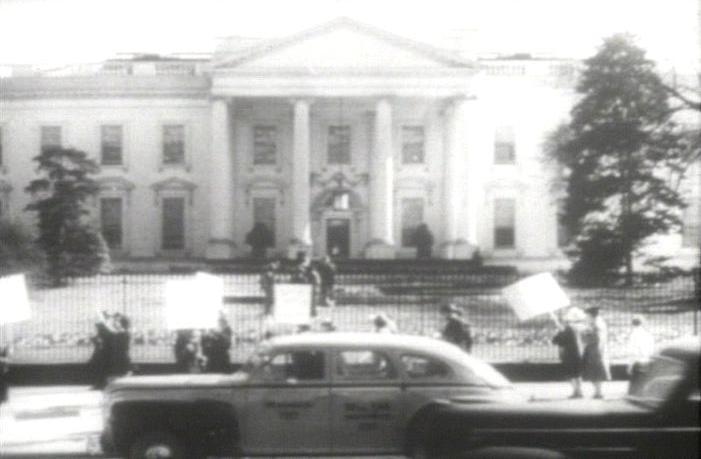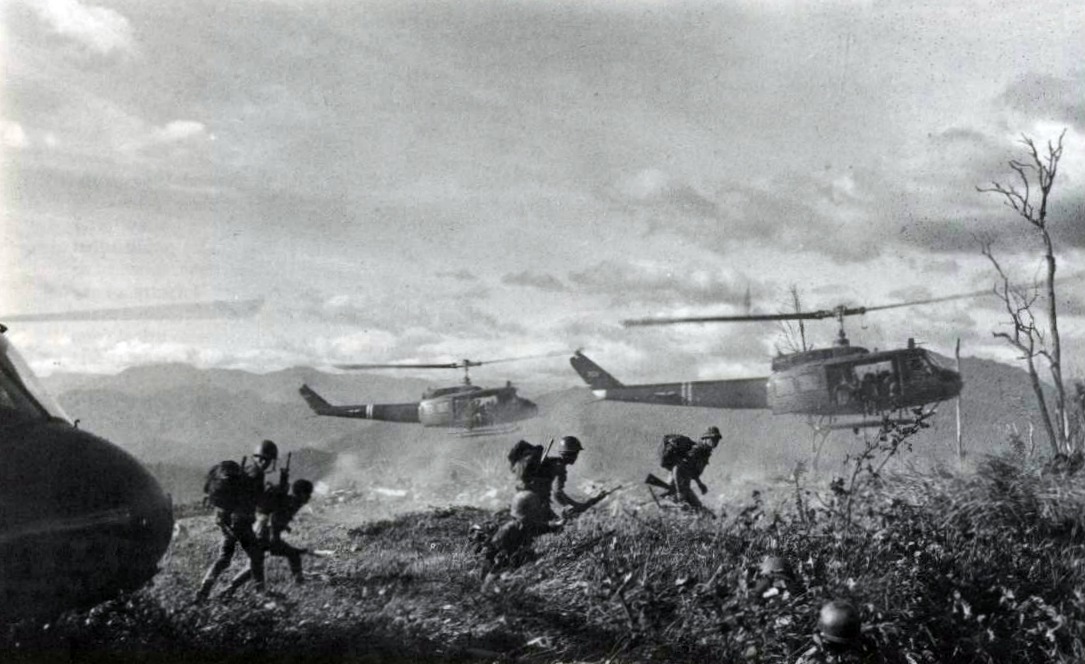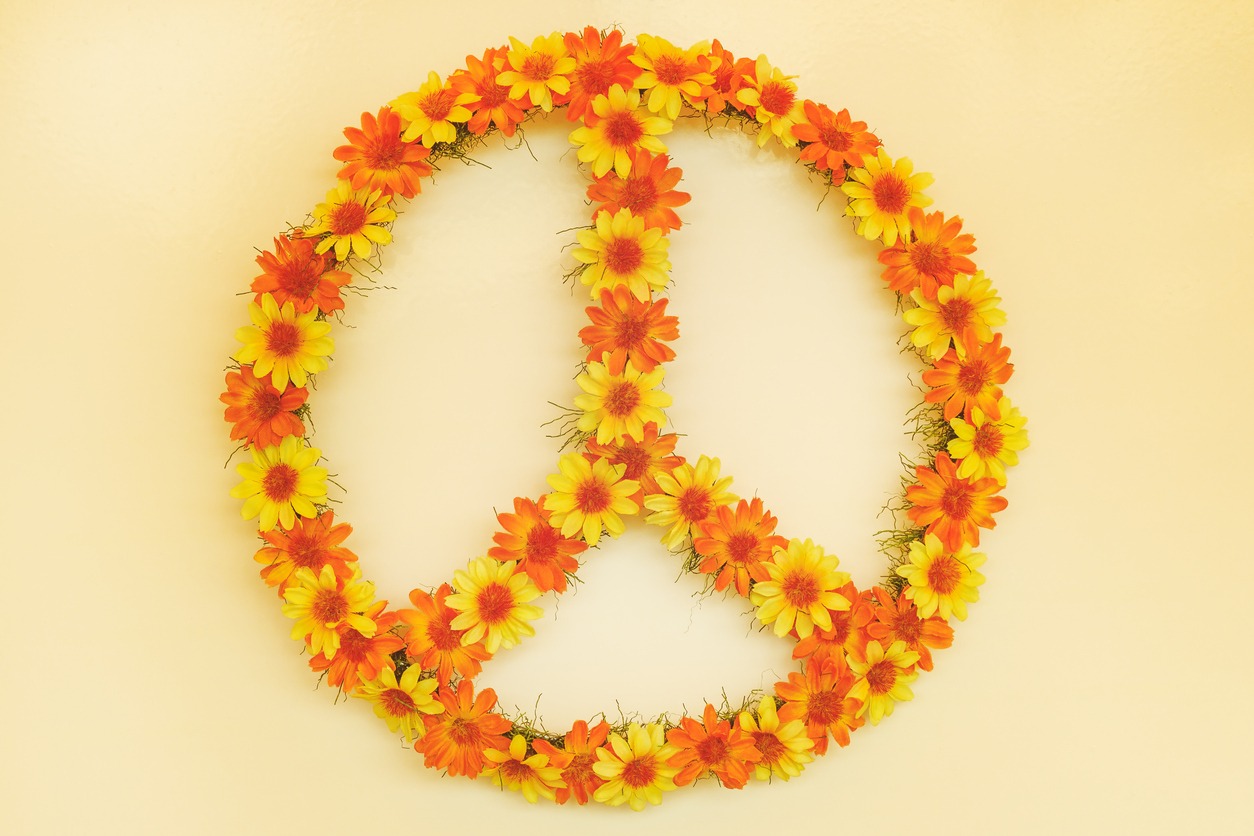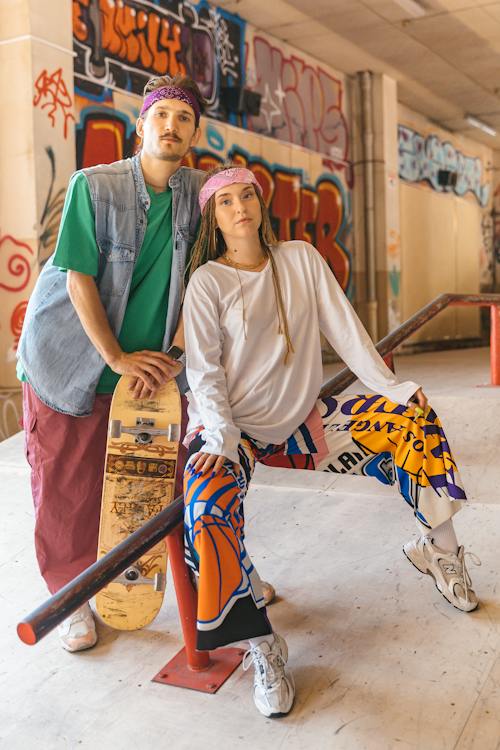During the 1960s, America was a tableau of upheaval and transformation, where fashion became a powerful medium of political expression and ideological protest. The peace symbol, now iconic, crystallized from this era of cultural revolution. It emerged as an emblem of the anti-war movement, primarily opposing the Vietnam War. This simple yet potent sign was adopted by the burgeoning hippie counterculture, which stood for love, peace, and communal living, starkly contrasting the mainstream values of consumerism and conformity.
Incorporated into clothing and accessories, the peace symbol transcended mere fashion to become a universal badge of dissent against violence and a declaration of solidarity with pacifist principles. Fashion in the 1960s was inseparable from the social currents of the time, with the hippie movement at its heart symbolizing a broader push for civil rights and equality. As such, garments like bell-bottom jeans, tie-dyed shirts, and flower crowns became intertwined with values of liberation and the pursuit of social justice, each thread and pattern articulating a language of resistance.

The enduring influence of 1960s peace symbol fashion is a testament to its effectiveness in communicating an ethos of change. It was more than a trend; it was a political statement, a lifestyle choice, and an integral part of the identity for many of those advocating for transformation during one of America’s most turbulent decades. Through fashion, the peace symbol provided not just a rallying point for those involved in the protests but also offered a vibrant and visual discourse that resonated globally, forging a timeless association between what we wear and what we believe.
Cultural and Historical Context
The 1960s were a pivotal decade in America, marked by dynamic social change and a growing counterculture that challenged mainstream norms. This era, energized by a quest for freedom and equality, saw fashion adopting new symbols of peace that transcended borders, profoundly influencing America and beyond.
Countercultural Movements
During the 1960s, San Francisco became the heart of countercultural movements, with the Haight-Ashbury district in particular symbolizing a melting pot of ideas and progressive thought. This time in America was characterized by movements toward sexual liberation, civil rights for African Americans, and environmentalism. The counterculture embraced a radical ethos promoting peace and multiculturalism, often clashing with the conservative mainstream.

Vietnam War and Political Unrest
The Vietnam War was a significant catalyst for political unrest across the United States. Protests and activism became commonplace as the decade witnessed increasing opposition to America’s involvement in Vietnam. The conflict spurred a nationwide debate on freedom and the responsibilities of a global superpower. The anti-war movement used fashion, including symbols of peace, as a form of silent protest against the turmoil overseas.
Influence of Eastern Philosophies
The 1960s also saw the rise of Eastern philosophies influencing American thought and lifestyles. Many Americans, including prominent figures in Hollywood, turned to India and other parts of Asia seeking spiritual enlightenment and alternative pathways to peace. This cultural exchange introduced new dimensions to American multiculturalism, evident in fashion through ethnic patterns, colors, and the iconic peace sign, which itself was inspired by the British Campaign for Nuclear Disarmament.
Iconic Fashion Items and Styles
The 1960s were marked by bold patterns, innovative silhouettes, and a blend of high fashion and countercultural influences. The era saw an emergence of iconic items that epitomized peace, love, and a revolutionary spirit in fashion.
Hippie Fashion Staples
- Tie-dye and Peace Signs: Integral to hippie style, tie-dye shirts adorned with peace symbols became synonymous with the movement. These colorful patterns embodied the psychedelic aesthetic and the peace-loving ethos of the era.
- Bell Bottoms and Long Hair: Flared pants were a hallmark of hippie fashion, often paired with long, unkempt hairstyles that rejected the conventional grooming standards of earlier decades.
- Medallion Necklaces and Headbands: Jewelry often featured peace signs, while headbands were a practical and fashionable accessory that completed the quintessential hippie look.
High Fashion and Designer Influence
- Mary Quant and the Mini Skirt: Mary Quant revolutionized women’s fashion with the mini skirt—a garment that captured the spirit of liberation and youthful rebellion.
- André Courrèges and Space Age: Courrèges introduced futuristic designs incorporating materials like plastic, and his work paralleled Pierre Cardin’s visionary aesthetic, which featured geometric shapes and unisex styles.
- Givenchy and First Lady Fashion: The refined elegance of Givenchy remained influential, with figures like Jackie Kennedy and Audrey Hepburn symbolizing the sophisticated side of the decade’s fashion.
Unconventional Fashion Statements
- Psychedelic Prints and Unisex Apparel: Designers like Rudi Gernreich and Paco Rabanne pushed boundaries with bold, mind-bending prints and garments that challenged gender norms, including unisex designs.
- Levi Strauss and Denim Revolution: The widespread adoption of denim by the mainstream, driven by companies like Levi Strauss, signified a shift towards more casual, versatile clothing.
- Boutique Culture and Ready-to-Wear: Small boutiques, exemplified by Barbara Hulanicki’s Biba, brought avant-garde fashion to the masses, making high fashion more accessible and aligned with the spirited zeitgeist of the times.
Symbols and Motifs

The fashion of the 1960s was a vibrant display of symbols and motifs which reflected the era’s social changes and cultural movements. Distinctive symbols like the peace sign became fashion staples, while the integration of psychedelic patterns and ethnic influences spoke to a generation advocating for peace, love, and freedom.
The Peace Symbol
The peace symbol, a circle enclosing a vertical line and downward-sloping lines, emerged as the iconic emblem of the 1960s. Often seen at anti-war protests, it transcended its initial purpose and was embraced by the fashion world. Peace signs adorned clothing, accessories, and even became part of jewelry designs, signifying the wearer’s alignment with the values of peace and non-violence that were pervasive during the sixties.
Psychedelic and Op Art Patterns
Psychedelic patterns, known for their swirling colors and hypnotic designs, were a direct reflection of the era’s flirtation with altered consciousness and visual experiences. Tie-dye, a technique that creates bright, saturated patterns on fabric, became synonymous with sixties fashion, representing a break from conventional styles. Op Art, short for Optical Art, used stark contrasts and geometric patterns to create the illusion of movement, influencing fashion with its dynamic and visually stimulating designs made from both natural and synthetic materials.
Ethnic and Folk Influences
The 1960s also saw an infusion of ethnic and folk elements into mainstream fashion. Clothing was influenced by non-Western cultures, incorporating materials such as patchwork, embroidery, and the use of natural fibers. These motifs were often combined with handmade details that offered a stark contrast to the growing presence of synthetic materials, marking a return to traditional craftsmanship and cultural richness. This blend of styles highlighted the decade’s appreciation for global influences and a growing sense of social consciousness in fashion.
Influential Figures and Icons
The 1960s marked a revolutionary period in fashion, symbolized by peace signs and echoed through the attire of key public figures. Icons from music, film, fashion, and politics not only defined the style of the era but also propagated the message of peace and love.
Music and Film Personalities
The Beatles burst onto the scene with their iconic suits and mop-top haircuts, later adopting psychedelic patterns that mirrored the peace movement. Jimi Hendrix, known for his virtuosic guitar skills, also became synonymous with 60s fashion through his flamboyant, military-inspired jackets and vibrant, patterned scarves. In the realm of film and Hollywood, Audrey Hepburn‘s elegant simplicity in movies like “Breakfast at Tiffany’s” contrasted with Brigitte Bardot‘s trendsetting beehives and bold eye makeup, both encapsulating different facets of 60’s style. Cher, with her trailblazing ensembles, showcased the fusion of mod and bohemian styles.
- The Beatles: Slick suits to psychedelic attire
- Jimi Hendrix: Flamboyant military jackets
- Audrey Hepburn: Simple, elegant fashion from “Breakfast at Tiffany’s”
- Brigitte Bardot: Beehives and bold eye makeup
- Cher: Mod-meets-bohemian

During this turbulent decade, designers such as Mary Quant and André Courrèges became emblematic of 60s fashion, introducing the mini skirt and space-age aesthetics, respectively. Yves Saint Laurent revolutionized women’s wardrobes with his pantsuits, while Barbara Hulanicki‘s Biba brought affordable fashion to the younger generation. Pierre Cardin‘s mod designs and Rudi Gernreich’s monokinis represented freedom and progression. Models like Twiggy and Jean Shrimpton not only flaunted these designers’ creations but also became fashion icons themselves, known for their distinctive and daring looks.
- Mary Quant: Creator of the mini skirt
- André Courrèges: Introduced space-age aesthetics
- Yves Saint Laurent: Innovated with women’s pantsuits
- Barbara Hulanicki: Biba, youthful affordable fashion
- Pierre Cardin: Mod designs, geometric patterns
Political and Cultural Leaders
Political figures, such as Jackie Kennedy, were instrumental in setting trends, her elegant suits and pillbox hats capturing the nation’s attention. In contrast, the hippie movement, centered in San Francisco, epitomized the anti-establishment ethos, promoting peace through psychedelic clothes, bell-bottoms, and tie-dye patterns. Diana Ross not only dominated the music charts but also became a fashion icon, her glamorous stage wear and extravagant costumes influencing the era’s style. These leaders and cultural icons were integral in popularizing the symbols of peace that defined the fashion of the 1960s.
- Jackie Kennedy: Pillbox hats and elegant suits
- Hippie Movement (San Francisco): Anti-establishment fashion, tie-dye, bell-bottoms
- Diana Ross: Glamorous stage wear and extravagant costumes
Legacy and Modern Resonance
The 1960s fashion, especially the peace symbols, have left an indelible mark on modern aesthetics and cultural movements, influencing styles, norms, and activist trends that persist to this day.
Impact on Contemporary Fashion
In the realm of contemporary fashion, the legacy of 1960s peace symbols endures. Designers often weave peace signs and psychedelic patterns into their collections, embracing not only the visual elements of the hippie style but also its spirit of rebellion and desire for social change. Luxury brands adapt these motifs for high fashion, while streetwear keeps them accessible, ensuring their presence across the fashion spectrum. They reflect a nostalgia for an era characterized by its vibrant push for multiculturalism and sexual liberation.
- Runway Collections: High-end designers integrate peace symbols with modern twists.
- Streetwear: T-shirts and accessories commonly feature the iconic peace sign.
- Music Festivals: Elements like frayed tie-dye shirts are staples at events reminiscent of Woodstock.
Peace Symbols in Today’s Culture
Peace symbols manifest outside the runway, deeply embedded in today’s culture. They appear on everyday items, from jewelry to home décor, signaling a continuum of the counterculture movement. The iconography serves as a reminder of the New Left and the era’s mission for social change, resonating with those who advocate for peace and equality in the present day.
- Merchandise: Widespread use on stickers, badges, and posters.
- Media: Peace signs feature in films and music videos that explore themes related to the 60s.
Ongoing Influence on Social Movements
The values that the peace symbols of the 1960s represented continue to inspire social movements. They are often present in demonstrations advocating for environmental causes, human rights, and anti-war sentiments, reflecting the sustained relevance of the symbol. The integration of technology has given these motifs a new platform, allowing them to reach a global audience and invigorate contemporary activist circles.
- Protests: Carried by demonstrators in rallies worldwide.
- Digital Platforms: Circulated through social media as part of modern-day protests.
- Education: Included in curricula that discuss the historical impact of Woodstock Music Festival and the sexual revolution on society.


